| |
Promotional video for the
Garlands for Judy Special Issue: Celebrating the 75th Anniversary of The Wizard of Oz
trt: 1:43
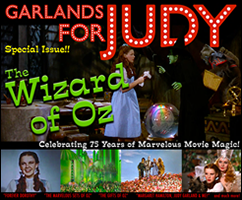 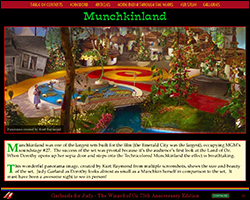 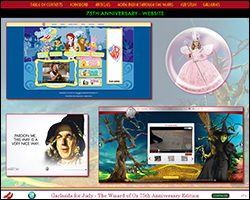
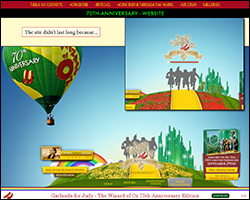 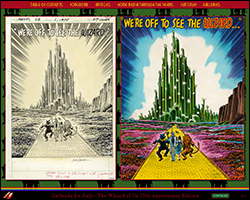 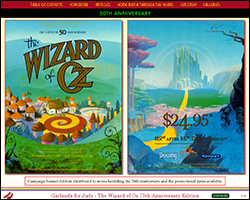

 
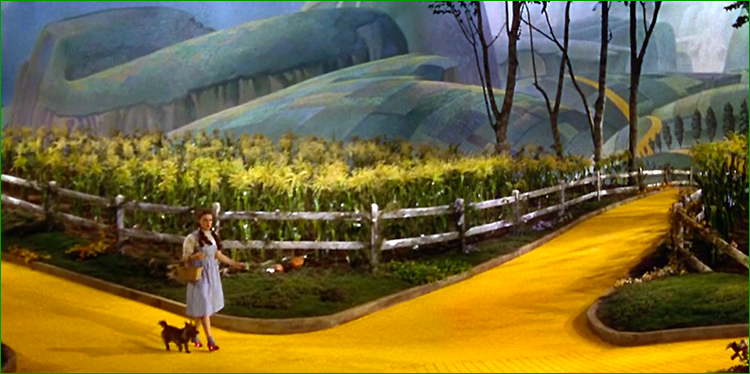
In late 1937 Arthur Freed was a songwriter at the MGM Studios with aspirations of becoming a producer of musicals, specifically featuring the talents of the studio's young contract player, Judy Garland. He told studio chief Louis B. Mayer that he wanted to produce a musical version of "The Wizard of Oz" starring Garland. Meanwhile, Mayer was in negotiations with producer Mervyn LeRoy to bring him over from the Warner Bros. Studios as MGM's "new Thalberg". Irving Thalberg was "The Boy Wonder" of Hollywood and MGM's chief of production. Sadly, he had passed away in 1936, the victim of a lifelong heart condition. Mayer turned to Mervyn LeRoy as a possible replacement, and LeRoy told Mayer that he wanted to produce a film version of "The Wizard of Oz". LeRoy had been a fan of the book series as a child and a fan of the hugely popular stage version that had made stars of Fred Stone and David Montgomery in the early part of the 20th century. Both Freed and LeRoy thought "The Wizard of Oz" would make a fantastic film musical and they received a boost to their aspirations when Walt Disney's first animated feature Snow White and the Seven Dwarfs opened to critical acclaim on December 21, 1937 and proceeded to break box office records around the world. The unexpected mega-success of Snow White naturally prompted the other studios to look around for a musical fantasy property of their own and "The Wizard of Oz" was high on many studio "wish lists".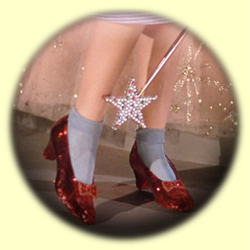
Over the years, many legends have been perpetuated about how "The Wizard of Oz" came to MGM and who could claim the credit. Some legends say that Mayer bought "Oz" solely for Freed while other legends state that it was purchased solely for LeRoy. In an interview decades later, LeRoy complained about being tired of hearing that the book was bought for Freed because as he said it was specifically purchased for him - with Freed acting as an associate producer. The sequence of events do support his claim: LeRoy's contract with MGM is dated February 3, 1938 - the studio purchased "The Wizard of Oz" from producer Sam Goldwyn (who at one point in the early 1930's had thought about filming it as a vehicle for Eddie Cantor) on February 18, 1938 and just a few days later on February 24, 1938 "Variety" published a notice that "LeRoy Will Produce 'Wizard of Oz'". It's safe to say that it was more than likely purchased for LeRoy, with Freed as his uncredited assistant. Just a day prior, on February 23, 1938 "Variety" reported that Freed had been promoted to "production assistant" in the "Mervyn LeRoy Unit at Metro". Regardless of who was actually responsible for MGM purchasing the book, there's no denying that Freed was the driving force behind most of the creative aspects of the film, especially the music.
Judy Garland's involvement in the project has also been clouded by myths and legends. People to this day still think that she was the second choice for the role. This is not true. As early as February 24, 1938 Louella Parsons reported that Judy was to play Dorothy.
That was the same date as the "Variety" notice noted above, which also stated "[MGM] has assigned Judy Garland to the role of Dorothy." But over the years, the brief involvement of Shirley Temple has become a huge, and false, legend. Perpetuated by the 1974 film That's Entertainment! which had Judy's daughter Liza Minnelli introducing a montage of clips from her mother's films, and in that introduction she states about OZ: "[MGM] even offered 20th Century-Fox Clark Gable and Jean Harlow just to get Temple for a certain picture...". The legend was that it was Jean Harlow's death in 1937 that killed the deal of loaning her and Gable to Fox to get Temple for OZ. In reality, Harlow died long before any negotiations or preliminary work on OZ began. But the legend persists to this day. Shirley Temple was never seriously considered for the role. An early January 1938 script idea of Dorothy as "an orphan in Kansas who sings jazz" was obviously written with Judy Garland in mind. Nicholas Schenck, head of MGM's parent company Loew's Incorporated, was against the project as a whole due to the expense, and in spite of the success of Snow White, fantasy was an expensive and dicey prospect at the box office. He felt the project needed a big name like Temple's to bring people into the theaters. To appease him, Freed sent his assistant (and Judy Garland's musical mentor) Roger Edens over to Fox to meet with Temple. He came back reporting that she was a "charmer" but not up to the vocal challenges of the role. So that was Temple's brief involvement. Another legend states simply that Fox flat out refused to loan Temple to MGM and so they were "stuck" with second choice Garland. This is also not true. The Wizard of Oz was always intended, from the very beginning, as a showcase for the MGM Studios and as a star making film for Judy Garland!
Even before the property was legally purchased on February 23, 1938, LeRoy and Freed were already tapping the vast resources of the MGM Studios to work on the various aspects of the film. Casting and character ideas were the first line of business. Due to the diligence of the writers assigned to the project (see complete list below), and the fact that various production delays kept pushing the start date further into the year, many extraneous and unnecessary characters and subplots were trimmed. Some of the original ideas included an antagonist for Dorothy named Lizzie Smithers (who sang opera - slated for Betty Jaynes). Smithers would become "The Princess of Oz" in the OZ sequences. Kenny Baker (who also sang opera) was to play a prince, then a duke, then a prince again, all paramours of the Smithers character. Miss Gulch was originally Mrs. Gulch with an obnoxious son named "Walter" who became the Witch's son "Bulbo" in OZ. There was a subplot about the Witch trying to take over the Emerald City; a woodpecker who ruins the Wizard's balloon so neither he nor Dorothy make it out of the Emerald City; a romance between Dorothy and Hunk (the Scarecrow); various subplots involving the Lion; and more. Luckily for us, the script was brought back to the simplicity of Baum's basic story.
One of the most important decisions was the hiring of Harold Arlen and E.Y. "Yip" Harburg to write the music and lyrics. Freed originally thought Jerome Kern should write the music (with either Roger Edens or someone else providing lyrics), but was swayed in favor of Arlen and Harburg after seeing their Broadway show "Hooray for What?" and loving their song "In the Shade of the New Apple Tree", which in Freed's mind had just the right fairy tale quality he wanted. 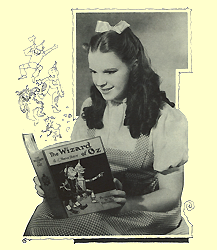 Freed was the person who suggested that the team write a ballad for Dorothy that would musically bridge the Kansas scenes to the OZ scenes. It's true that the melody for "Over the Rainbow" came to Arlen while riding in his car past the famous Schwab's Drug Store in Hollywood. He had his wife pull over so he could jot down the music. The first time he played if for Harburg, he excitedly over-played it resulting in Harburg's dislike of the tune and remarking that the song was more for operetta star Jeanette MacDonald than a Kansas farm girl. After Arlen played it again in a more simple straightforward way Harburg loved the tune and went to work writing the lyrics. It's now a bit rote to mention that they ended up writing one of the greatest scores in film history. Excepting "Over the Rainbow", the songs are deceptively simple, which is part of their magic and why they work so well. OZ was the first Technicolor musical to successfully integrate the songs into the plot. It's also true that "Over the Rainbow" was deleted for at least one preview, because executives thought it slowed down the film. Judy herself would later joke that executives objected to the "little FAT girl" singing in a barnyard! Freed later said that he stormed Mayer's office exclaiming "If the song goes, I go too!" It stayed, and went on to win the Oscar for "Best Song". It's been mentioned before, but it's important to note here that if someone other than Judy Garland had played Dorothy, "Over the Rainbow" would never have been written. Arlen and Harburg were already big fans of Garland. They both recognized and responded to the unique vulnerability that was always a part of the undercurrent in her voice, even in her early teens. Freed was the person who suggested that the team write a ballad for Dorothy that would musically bridge the Kansas scenes to the OZ scenes. It's true that the melody for "Over the Rainbow" came to Arlen while riding in his car past the famous Schwab's Drug Store in Hollywood. He had his wife pull over so he could jot down the music. The first time he played if for Harburg, he excitedly over-played it resulting in Harburg's dislike of the tune and remarking that the song was more for operetta star Jeanette MacDonald than a Kansas farm girl. After Arlen played it again in a more simple straightforward way Harburg loved the tune and went to work writing the lyrics. It's now a bit rote to mention that they ended up writing one of the greatest scores in film history. Excepting "Over the Rainbow", the songs are deceptively simple, which is part of their magic and why they work so well. OZ was the first Technicolor musical to successfully integrate the songs into the plot. It's also true that "Over the Rainbow" was deleted for at least one preview, because executives thought it slowed down the film. Judy herself would later joke that executives objected to the "little FAT girl" singing in a barnyard! Freed later said that he stormed Mayer's office exclaiming "If the song goes, I go too!" It stayed, and went on to win the Oscar for "Best Song". It's been mentioned before, but it's important to note here that if someone other than Judy Garland had played Dorothy, "Over the Rainbow" would never have been written. Arlen and Harburg were already big fans of Garland. They both recognized and responded to the unique vulnerability that was always a part of the undercurrent in her voice, even in her early teens.
The rest of the MGM creative staff included
MGM costume mastermind Gilbert Adrian who happily and brilliantly designed over four thousand costumes for the film. Cedric Gibbons and his art department out did themselves in designing the sets and props and backdrops. Everything was done with the utmost attention to detail, and they surpassed even their own previous triumphs (such as their recent work for MGM's opulent black and white Marie Antoinette). The Munchkinland set alone is a masterpiece of what a studio like MGM could create, and will probably never be duplicated. Besides, today everything would be done digitally, but Munchkinland was all built to scale and filled MGM's biggest sound stage.
Some casting issues arose during this pre production process. Ray Bolger and Buddy Ebsen were originally cast as the Tin Woodman and Scarecrow, not the other way around. Bolger pushed for the switch, knowing that his style of performing was more suited to the Scarecrow. MGM made the change without any issues. The casting of the Wicked Witch was another story. Gale Sondergaard had originally been cast as a glamorous witch, much like Disney's Wicked Queen in Snow White. A minor studio controversy arose because Freed and others were insistent and adamant that the witch be an ugly old hag. A more traditional scary witch. They prevailed and the beautiful Oscar winning Ms. Sondergaard gamely made tests of some new "ugly" make-up and decided that being ugly just wasn't for her. Margaret Hamilton got the role - and ran with it!
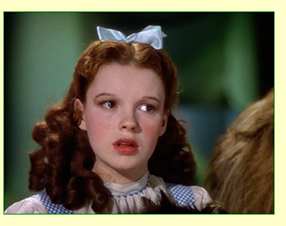
Filming finally began on October 13, 1938 with Richard Thorpe directing. 11 days later, he was fired. In this short time, he managed to film Dorothy's meeting with the Scarecrow and some of the scenes in the Witch's castle. Nothing he filmed was considered usable. It lacked the "fairy tale feel" that LeRoy and Freed wanted. Judy was costumed in a different dress and the now infamous "Lolita of Gale" blonde hair and glamour girl make-up. Margaret Hamilton and Ray Bolger's costumes and make-up were also different than how they would appear in the final film. But the biggest change of all was the replacement of Buddy Ebsen as the Tin Woodman. Just a few days before Thorpe's firing, Ebsen suffered an allergic reaction to the aluminum powder used to make his costume look silver (the Tin Woodman's costume was actually made of leather, treated to look like tin). Ebsen was placed in an iron lung and had to be taken off the film. A call went out to 20th Century-Fox to hire Jack Haley. His make-up is changed to a paste, and neither he nor the public are told the real reason for Ebsen's exit. The studio said that Thorpe was "ill" and had to be taken off the film, and down played the cast change from Ebsen to Haley, also citing illness. No word was made of the severity of Eben's "illness".
Before filming began again, director George Cukor came on as an interim director. Even though he's wasn't really interested in the film, and was biding time to start David O. Selznick's epic Gone With The Wind, his changes to OZ were far reaching, and would have a lasting effect on the film and its success. He first scrubbed Judy's face of most of the make-up, got rid of the blonde wig, and gave her invaluable advice on her acting by telling her to remember that she's "just a little girl from Kansas". Evidently, Thorpe had her acting in a "fancy" sort or way (none of the Thorpe footage survives). Cukor also changed the costumes and make-up for both Ray Bolger and Margaret Hamilton. He then happily left OZ for the Tara plantation.
When filming began again on November 4, 1938, the no-nonsense "man's man" director Victor Fleming was at the helm. He turned out to be perfect for the role. Even though he had never directed a musical or fantasy, he was adept at almost every other genre, was known for bringing in his pictures on time, and for being able to handle multiple major stars with their multitude of idiosyncrasies and egos.
Fleming's tenure wasn't without incident. Most of the filming went along smoothly, but a film the size and scope of OZ was bound to have its share of problems and accidents. A minor hiccup in the filming occurred while filming the scenes in the Tin Woodman's forest. After three days of footage had been shot, it was realized that the Tin Woodman's costume was in the shiny pristine condition it was for the post "Wash & Brush Up Company" scenes (which had already been filmed), rather than in a state of rust and disrepair as if he had been "rusting over there for the longest time." The costume was sent back for appropriate "rusting" (in reality it was treated leather, not metal or tin - sound effects would be dubbed in later), and the scenes were reshot.
A major accident occurred while filming the Munchkinland sequence. In an interview done years later, Margaret Hamilton told the story of how, when filming the Witch's exit from Munchkinland, everything went smoothly. The fire cameup after Hamilton was lowered beneath the stage floor in a cloud of smoke. After lunch, everything went wrong, culminating in the fire coming on too soon and severely burning Hamilton. She was rushed to the hospital and was off the film for a few months. If it wasn't for her make-up assistant immediately scrubbing off the copper based make-up, her face would have been permanently disfigured. In the end, the shot seen in the film was the only usable, pre-lunch-break take.
Some other minor accidents occurred, such as wires snapping and dropping a Flying Monkey (played by an unfortunate little person who wasn't seriously injured), Hamilton's stand-in Betty Danko sustaining injuries after a flying broom special effect went wrong, and even Toto was off the film for a short time after someone stepped on him!
In spite of these incidents, most of the filming went along without mishap and was generally a happy experience. Except for possibly Ray Bolger, Jack Haley, and especially Bert Lahr. They suffered the most in their heavy make-up and costumes under the intense heat emanating onto the set from the dozens of hot lights needed to light the sets for the early Technicolor cameras. The lights were needed to ensure the action was captured correctly on the sensitive film. The Technicolor cameras were one of the major obstacles to all of the filming, necessitating longer set-ups and tests of the lights and colors (and costumes and make-up and so on) than a conventional black and white film. In a 1939 interview Jack Haley noted that "we were lucky we got four setups shot in a day."
In mid-February 1939, after most of the Technicolor OZ sequences had been shot, Fleming left to take over directing Gone With The Wind (ironically enough from George Cukor). The OZ cast gave him a going away party on February 17th. Veteran MGM director King Vidor came on board and directed the Kansas sequences plus some Technicolor OZ pick-up shots. Although he didn't get screen credit and was not an "official" director of the film (only Fleming was credited), he was instrumental in the overall effect and subsequent magic of Judy's singing "Over the Rainbow". Coming from a silent film background, Vidor was adept at creating mood and emotion without dialog but solely with camera movement. In this case, with the flow of the music as well. He kept Judy moving for most of the song. Vidor later recalled how up to that point most ballads had been filmed static, with the performer just standing still singing to the camera. He moved Judy to the beat of the music much as he had brilliantly moved his soldiers in the woods to the slow beat of an unheard drum in his 1925 masterpiece The Big Parade. To this day "Over the Rainbow" is, in this writer's opinion, still one of the greatest musical sequences ever put on film.
Filming was officially completed the first week of March, 1939. Shortly thereafter, Ray Bolger re-recorded some of his "If I Only Had A Brain" and re-filmed the extended (and ultimately deleted) dance sequence, re-choreographed by Busby Berkeley. A week later editor Blanche Sewell assembled a rough cut of the film, and it went into post production for scoring (see the OZ Discography), sound effects, special effects, and a few re-takes and pick-up shots. The post production process lasted for another several months.

In early June, the film was finally ready for a series of previews. These previews helped LeRoy, Freed, Edens and the rest of the production staff decide how to trim the film down from it's existing almost 2 hour length to a more audience friendly 90 minutes (the final running time of the film was, and is, 103 minutes). Cut after the previews were the Scarecrow's extended dance, a scene where the Witch turns the Tin Woodman into a beehive, several lines of dialog spoken by the Wicked Witch (and deemed a bit much for children of the day), and most famously "The Jitterbug" song and dance. Also taken out, then put back in, then taken out, then put back in was "Over the Rainbow". LeRoy claimed that "six MGM executives" objected to Judy singing in a farmyard, and that it slowed down the film. Freed later claimed that he went to Louis B. Mayer and gave him the ultimatum: "The song stays or I go!" Luckily for all, the song stayed.
Contrary to the notion that the film premiered at Grauman's Chinese Theatre in Hollywood on August 15, 1939, in reality it had it's world premiere at The Strand
Theatre in Oconomowoc, Wisconsin on August 12, 1939.
This was done to open the film in the American "Heartland" for the target audience. It's first gala premiere was most definitely at Grauman's on August 15th. Then in New York on August 17th.
The Wizard of Oz was a huge success during its initial release. The film received mostly glowing and ecstatic reviews even though a false legend has persisted over the years that the film was a failure both critically and financially. In reality, the few negative reviews were definitely in the minority. OZ was a financial success until the costs of promotion, prints, etc. were added in (even the pre-production cost of the purchase of the rights to the book!), and the fact that over half of the audience paid a reduced (children’s) ticket price. The film went on to be loved as much by audiences around the world as it was initially in the United States.
OZ was nominated for 5 Academy Awards, including Best Picture. 1939 is considered the greatest year in Hollywood's history, and a total of NINE films were nominated for Best Picture! For the record, OZ was up against: Gone With The Wind (winner); Dark Victory; Mr. Smith Goes To Washington; Ninotchka; Of Mice And Men; Goodbye, Mr. Chips; Wuthering Heights; Love Affair; and Stagecoach. OZ won for Best Song ("Over The Rainbow") and Best Music (Herbert Stothart), and Judy received a special "juvenile" award for her "outstanding performance as a screen juvenile during the past year." In 1939, in addition to OZ, Judy enjoyed the success of her first musical pairing with Mickey Rooney in Babes In Arms. Rooney was nominated for Best Actor for Babes In Arms, making one wish the Judy had not been relegated to the "juvenile" award. But regardless of how great her performance is in OZ, she would still have lost to Vivien Leigh's amazing performance in Gone With The Wind. The real head scratcher is the Visual Effects Oscar. OZ should have won, but instead lost to The Rains Came, a film that's little known today. Finally, Victor Fleming probably would have been nominated for Best Director for OZ if he wasn't already nominated (and won) for Gone With The Wind.
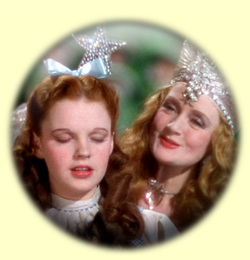
MGM would successfully re-release OZ in 1949 and 1955. In 1956 the studio rented the film to CBS TV for two showings, premiering on November 3, 1956. The second showing wasn't until December 13, 1959. It was so successful that the film would be aired on TV every year hence, becoming a true American tradition - and turning the film and its characters and actors into icons of American culture.
Today - and thanks to its unique status as a yearly TV event - OZ is considered to have been seen by more people than any other in history. Lately, it's not the highly anticipated yearly event on broadcast TV that it was. Since being bought by Tuner Entertainment (along with the rest of the MGM catalog of films), OZ has been shown more than once a year on cable TV. Turner Classic Movies has shown the film each year during the 4th of July weekend, creating its own tradition. Regardless of this, the film continues to be an icon, and along with Gone With The Wind its memorabilia are the most popular and highly sought after with serious and amateur collectors all over the world. OZ items consistently fetch high prices at auctions. The Ruby Slippers are definitely the "Holy Grail" of movie memorabilia, one of several existing pairs selling for $600,000 in 2000!
Thanks to the home video market that began in the late 1970's, OZ will always be a staple in the homes of families around the world. Coupled with the cable TV showings, and occasional showings on broadcast TV, it's safe to speculate that OZ will always be a cherished part of childhood AND adulthood. It's a one of a kind film with a magic all its own - a magic that has stood the test of time and will continue to entrance and enchant audiences for as long as movies are shown, in any format.
For more detailed information, check out the timeline below, and also the external links below. |
top of page
 |
 
The links below are just a sampling of the many wonderful OZ images out there. It's doubtful we could include every single OZ image that exists, for now...
OZ photos have become some of the most popular and most collectible, ranging from original 8x10's to original artwork to poster and more recently: computer enhanced images.
If you have any photos you think should be added, please email the webmaster. |
|
top of page
 |
 
There are probably enough OZ related media products & collectibles to fill up several servers' worth of web space. In fact, The Wizard of Oz runs neck and neck with Gone With The Wind as the most popular film for collectors of all types of movie related memorabilia and collectibles although I believe that OZ has most likely surpassed it by this point!
The images below are link to a sampling of the various OZ media
throughout the past 75 years
(click on the images below to see the galleries).
Enjoy, and Happy Collecting!
If you're looking for more,
the links provided at the bottom of this page are great resources to begin your search.
|
|
 
DATE |
EVENT |
05-07-1898 |
This is the supposed date that L. Frank Baum came up
with the name of the magical land that he entertained local children with
stories of. Legend has it that one of the children said "Where did they
live?" and Baum looked at the bottom drawer of a filing cabinet with the
letters "O - Z". Thus, OZ was born. |
1900 |
The book "The Wonderful Wizard of Oz",
written by L. Frank Baum with illustrations by W.W. Denslow, is published and
becomes an immediate best seller. Baum would write 13 more Oz books. |
1902 |
David C. Montgomery as the Tin Woodman and
Fred A. Stone as The Scarecrow find fame in the first notable
stage version of The Wizard of Oz. |
1903 |
The stage show moves to Broadway and lasts for 293
performances. A huge hit for the time. |
09-24-1908 |
The Fairylogue and Radio-Plays silent film premieres
in Grand Rapids, Michigan. L. Frank Baum himself plays The Wizard. |
10-10-1914 |
His Majesty The Scarecrow Of Oz silent film is released. The film is written and produced by L. Frank Baum. |
1921 |
Another silent version of the story is begun by
director Ray C. Smallwood but is never completed. |
1925 |
Silent film The Wizard of Oz starring Oliver Hardy as the Tin Woodman. Released by Chadwick Pictures, also starring G. Howe Black,
Charlie Murray, Larry Semon (he played The Scarecrow and directed the film),
and Dorothy Dwan as a very 1920's vampish Dorothy. |
1932 |
The Meglin Kiddies release a short film The Land of
Oz. |
1933 |
Cartoon short of The Wizard of Oz is produced but
never released due to copyright issues. |
09-25-1933 |
NBC Radio broadcasts a "Wizard of Oz"
program that runs three times a week and lasts through March 23, 1934. Nancy
Kelly plays Dorothy. |
01-31-1938 |
Arthur Freed prepares a tentative outline of the
principal OZ actors. This included the ultimately deleted "Princess of
Oz, who sings opera" (Dorothy at this point was listed as "An
orphan in Kansas who sings jazz"); and a "Prince" - these
characters were to be played by Betty Jaynes and Kenny Baker. |
02-18-1938 |
MGM purchases the rights to The Wizard of Oz from
Sam Goldwyn (who had originally thought of the property as a vehicle for
popular comedian Eddie Cantor). It wouldn't be until June 2, 1938 that the
legal rights were finally confirmed. Goldwyn received his check on June 8th. |
02-23-1938 |
Daily Variety announces that
Arthur Freed has been promoted to "Production Assistant" to
"the Mervyn LeRoy Unit at Metro." |
02-24-1938 |
First public notice that MGM is producing The Wizard
of Oz. Daily Variety announces that "LeRoy Will Produce 'Wizard of
Oz.'" "Metro has acquired the screen rights for 'The Wizard of Oz'
from Samuel Goldwyn and has assigned Judy Garland to the role of Dorothy.
Mervyn LeRoy will produce the Frank Baum childhood fantasy."
Later on this same day, Louella Parsons reports in the Examiner that
"Judy Garland to Play Dorothy in Metro's 'Wizard of Oz' Film." |
02-26-1938 |
Interoffice memo is distributed by Mervyn LeRoy's
assistant, William Cannon, regarding the overall look of the film: "The
whole background should be more modernized than it is in the book to appeal
to the modern person's idea of a Fairyland. When L. Frank Baum wrote this
story which was before 1900, there were no autos, no radios, no airplanes and
I do believe if he had written it today he would have in some manner made it
a little more acceptable to the audience on a basis of using some of the modern
contrivances that we use today. I think our Wizard of Oz background should
be a Fairyland of 1938 and not of 1900." [Cedric Gibbons] |
03-01-1938 |
The Hollywood Reporter takes its cue from Arthur
Freed's original list of names and characters, and reports the involvement of
Kenny Baker as a "Prince of Oz" and Betty Jaynes as "A
Princess of Oz" (who sings opera!). Baker's rolled is switched to a
duke then back to a prince before finally being written out (with Jaynes) of
the script completely. Thank goodness! |
03-05-1938 |
Daily Variety reports that The Wizard of Oz will
feature "Ray Bolger and an all-star cast." This is the only known
time that Judy Garland's name did not appear in press about the film. |
03-07-1938 |
Herman Mankiewicz begins three weeks' work on the
script, including a rough summary and an incomplete script of the first part
of the movie. |
03-17-1938 |
MGM sends out a press release stating that Mack
Gordon and Harry Revel are going to write the songs for the film. |
03-19-1938 |
Script submitted by Herman J. Mankiewicz. |
04-18-1938 |
Daily Variety announces that Nacio
Herb Brown (Freed's songwriting partner) and Al Dubin (of the Warner Bros.
Busby Berkeley musicals fame) would write the songs for the film. |
04-19-1938 |
This was a planned start date for the film. |
04-25-1938 |
Arthur Freed sends screenwriter Noel Langley (who's
been working on the script for some time), a very long memo detailing various
items he thinks will help make the film a success. |
04-29-1938 |
Judy Garland poses for Max Factor for what are
considered the earliest hair and makeup tests she made for the film, which
includes an early version of the famous blond wig. |
05-03-1938 |
Interoffice memo is distributed noting that Harold
Arlen and E.Y. Harburg will write the songs for the film. |
05-04-1938 |
"Temporary List of Effects" includes a
crystal and mirror that the Wicked Witch views the four travelers through (in
the final film, it's simply the crystal ball that she looks into); and a
"Buggy on way to Witch's castle" that is assumed was intended to
help rescue Dorothy.
New script is prepared. |
05-06-1938 |
List of effects that might be needed in the film is
prepared by the Visual Effects department that includes "book opening
routine" |
05-09-1938 |
This was a planned start date for filming to begin.
Harold Arlen and E.Y. Harburg's first day of working
on the film. The first song they write is the ultimately deleted "The
Jitterbug". |
05-13-1938 |
Director Norman Taurog signs a long term contract
with MGM. His first assignment is Boys Town with Spencer Tracy and
Mickey Rooney. The next day MGM announces this and notes that after Boys
Town he will direct The Wizard of Oz. |
06-04-1938 |
Florence Ryerson and Edgar Allan Woolf begin writing
drafts of the script, through June 8, 1938.
This is the date of Noel Langley's "final
draft" of the script. Luckily by this point the Kenny Baker and Betty
Jaynes characters are gone. Still in the script are ultimately deleted
scenes such as the Wicked Witch's plot to conquer the Emerald City. Mrs.
Gulch (not Miss yet) had an obnoxious son named "Walter" that
became the Witch's son "Bulbo" in Oz. A woodpecker ruins the
Wizard's balloon so neither he nor Dorothy make it out of the Emerald City.
And Dorothy, the Scarecrow, Lion, and Tin Woodman build a human pyramid to peek
into a rear window of the Wizard's palace in an attempt to see him! |
06-06-1938 |
(Approximate) Florence Ryerson and Edgar Allan Woolf
are brought in to work on the script. |
06-09-1938 |
Mervyn LeRoy's assistant, William Cannon, prepares a
list of the songs written for the film so far and songs that have not yet
been completed. The completed songs are "The Jitterbug", "If
I Only Had A Brain/Heart/Nerve", The Munchkinland Musical Sequence,
"If I Were King of the Forest" and "Over The Rainbow".
A new script is prepared. |
06-13-1938 |
New script. Features the Lullaby League handing
Dorothy a flower covered safety pin after welcoming her, and Dorothy being
led to the end of Munchkinland where the Yellow Brick Road intersects and
then she says "Follow the yellow brick road and I can't go wrong."
Obviously, the filmed version is a definite improvement! |
06-15-1938 |
New Script. This includes both good witches, a
"Witch of the North" and Glinda. They would be merged into
"Glinda, the Witch of the North". |
06-22-1938 |
A list of the cyclone effects needed for the film
are: "Cyclone Approaching Kansas Farm"; "Cyclone Hitting
Farm"; "Cyclone Lifting Farm House into Air"; "Key of
Cyclone Approaching - for Cellar Door Cut"; "Farm House Whirling
Around in Cyclone". |
07-05-1938 |
New script. This time it mentions that the Witch
had clipped Nikko's (her personal Flying Monkey) wings, resulting in some
short wings tested for the costume. Also tested were bat wings and the wings
as they would appear in the final film. It also mentions that Nikko puts the
bucket of water into Dorothy's hand to throw on the Witch. |
07-12-1938 |
"Temporary List of People Requiring
Costumes" is prepared for distribution. This list includes every single
person that was intended to appear in the film. Quite a list! It included
"35 Munchkins with Special Business" (i.e. the Mayor, etc.);
"58 Men Assorted Munchkin Townsmen"; "31 Women Assorting
Munchkin Townswomen"; The Munchkin Navy; The Munchkin Fire Department;
even a Mother Goose Club (totaling 124 Munchkins in all).
Also listed are "300 People
for All the Scenes in the Emerald City". Included solely for the
background were "20 Men Shop Keepers"; "10 Street Vendors -
Men"; "25 Townsmen Gentlemen"; "20 Shop Keepers
Wives"; "25 Women Wives of the Gentlemen"; "26 girls 18
to 25 years"; "41 Women Assorted Townswomen"; "100
Assorted Townsmen". |
07-25-1938 |
Another version of the script. Includes a note to Mervyn
LeRoy indicated rewrites needed to reflect the new characterization of the
Wicked Witch, as well as a description of the Winkies as "huge figures
with grotesque and hideous headdresses like the deather's head helmets in
Japanese armor. They are absolutely inhuman."
In the Hollywood Citizen-News, Sidney Skolsky announces the casting of Bert Lahr. |
08-20-1938 |
In the Hollywood Citizen-News, Sidney Skolsky notes that Mervyn LeRoy approached Robert
Benchley to play the role of The Wizard.
Press releases are sent out announcing Gale
Sondergaard has been cast in the role of "The Wicked Witch of the
West". |
08-27-1938 |
Judy poses for hair, costume and makeup tests
wearing the infamous blond wig she would wear during the first few weeks of
filming as well as a red wig that was never filmed.
Bert Lahr also poses for costume and makeup tests in an early unused version
of the Lion's costume.
MGM contract player Mitchell Lewis poses for costume and makeup tests as the
"Captain of the Winkie Guard". |
08-29-1938 |
Louella Parsons mentions in her column for the Examiner that Frank Morgan is being
considered for the role of The Wizard. |
09-01-1938 |
In her column for The Hollywood Reporter, Alta
Durant notes that Mervyn LeRoy is still looking for a dog to play
"Toto". "…a Scottie, a well-educated one, a dog intelligent
enough to follow Judy Garland through several sequences of The Wizard of
Oz".
The Hollywood Reporter notes that
Richard Thorpe will direct the film. |
09-03-1938 |
The Hollywood Reporter notes that
Frank Morgan has "the inside track" for the part of The Wizard. |
09-06-1938 |
The Hollywood Reporter notes that
now Charles Winninger is being considered for the part of The Wizard. |
09-09-1938 |
Bert Lahr enters into his agreement with MGM to play
the Cowardly Lion for a minimum of 6 weeks work, at $2,500.00 per week. The
salary start date is given as 09-12-1938.
Now it's reported that W.C. Fields is going to
receive $150,000.00 for playing The Wizard. Louella Parsons adds
that he would sign for the film on September 9th or 10th. |
09-12-1938 |
Louella Parsons mentions in her column for the
Examiner that Billie Burke will play the "Good Witch". |
09-14-1938 |
Costume tests are done for the Winged
Monkeys, this time with small wings. |
09-15-1938 |
Proposed start date for filming that didn't happen. |
09-20-1938 |
Revised start date for filming that didn't happen. |
09-21-1938 |
Bert Lahr poses for costume and makeup test stills
in an ultimately discarded version of his Lion costume.
Daily Variety notes that Frank
Morgan is doing a screen test for the part of The Wizard. |
09-22-1938 |
Frank Morgan is assigned the role of The Wizard. Being under contract to MGM, he was not required to sign a new
agreement.
Ray Bolger poses for costume and makeup stills as he
would appear in the ultimately discarded "Thorpe footage". His
makeup and costume would be altered when George Cukor spends a short time on
the film.
Buddy Ebsen also poses for makeup and costume stills in his
Tin Woodman costume.
Gale Sondergaard poses for costumes tests as the glamorous Wicked Witch in a
form-fitting black sequined outfit.
More Winged Monkey costume tests, this time with a little hat
and large and small versions of the wings. |
09-23-1938 |
Revised start date for filming that didn't happen. |
09-26-1938 |
Filming is now scheduled to begin on October 10th. |
09-30-1938 |
Recording Session: Judy, Bert Lahr, Ray Bolger and
Buddy Ebsen record "If I Only Had The Nerve" and "We're Off To
See The Wizard".
Plus: "If I Only Had A
Heart" (Ebsen), "If I Only Had A Brain" (Bolger & Judy).
And "The Jitterbug"
(Bolger, Ebsen, Lahr, & Donna Massin filling in for Judy). |
10-01-1938 |
MGM Recording Session: "If I Only Had A
Heart" (Haley). |
10-03-1938 |
Gale Sondergaard poses for costumes tests in the
revised Witch's costume, making her the more traditional ugly
"hag".
Ray Bolger & Buddy Ebsen pose for more makeup and costume test
stills.
More Winged Monkey costume tests, this time with
bat-like wings. |
10-04-1938 |
MGM announces that it has signed the well known
vaudeville animal impersonator Pat Walshe to play "Nikko" (the
Wicked Witch's sidekick). |
10-06-1938 |
A blueprint of the set of the Witch's Tower Room is
completed. This blueprint is amazing in its detail, partly because the set
was to be filmed from all angles, and partly due to the attention to detail
that MGM gave to all aspects of all their films. Some of the details unseen
in the final film are the signs of the zodiac on the floor around the
circular podium that holds the crystal ball.
Recording Session: Judy, Bert Lahr, Ray Bolger and
Buddy Ebsen record "The Jitterbug". |
10-07-1938 |
Recording Session: The first ever recording of
"Over The Rainbow" by Judy Garland. |
10-08-1938 |
Ray Bolger poses for more costume and makeup stills
as he would appear in the ultimately discarded "Thorpe footage".
His makeup and costume would be altered when George Cukor spends a short time
on the film.
MGM Recording Session: "If I Only Had A
Heart" (Haley). |
10-11-1938 |
Recording Session: Judy, Ray Bolger and Buddy Ebsen
record "We're Off To See The Wizard"; Judy, Ray Bolger, Buddy Ebsen
and Bert Lahr record "If I Were King Of The Forest". |
10-12-1938 |
On set tests are made. |
10-13-1938 |
Filming officially begins under the direction of
Richard Thorpe. Judy is costumed in the blond wig, heavy "baby
doll" makeup, and blue cotton pinafore with the blue polka dot
border.
Munchkin costume tests are made, including the Mayor and
"Lollipop Guild" (written as "3 Little Tough Boys" on the
test board). |
10-15-1938 |
Test stills are shot of the Flying
Monkey makeup. |
10-17-1938 |
Original Tin Woodman Buddy Ebsen poses for costume test
stills.
Scenes in the Witch's castle begin filming this
week.
The reprise of "Over The Rainbow" as performed on set by Judy in
the Witch's Tower Room is filmed. This was deleted and the footage does not
survive. The recording does, and is included on the Ultimate Oz laser set,
and the 1995 Rhino 2-CD deluxe edition of the film soundtrack. |
10-21-1938 |
Scenes of Dorothy & Co. fleeing down the stairs
to the entrance hall of the Witch's castle are filmed.
Daily Variety reports the next day that the scene is "said to be the
longest boom shot ever made in color."
This is also the last day
of filming for Buddy Ebsen as "The Tin Woodman". He suffered an
intense allergic reaction to the aluminum powder used in his makeup that he
had been inhaling all this time. He is put in the hospital and taken off the
film. He doesn't return to MGM until December 13th (for the film "Four
Girls in White"). |
10-24-1938 |
Filming is halted. Richard Thorpe is fired. His
footage is deemed unusable and lacking the "fairy tale feel".
Everything would have to be reshot! |
10-25-1938 |
George Cukor replaces Richard Thorpe as
director.
Hedda Hopper's column reports about visiting the Wicked Witch's Castle set,
in which she marvels about the costumes and mentions Judy's blond wig. |
10-26-1938 |
New director George Cukor issues a memo notifying
producer Mervyn LeRoy that "Before production continues, George Cukor
will be shooting new hair and wardrobe tests of Judy Garland. Please notify
all concerned to give Mr. Cukor their full co-operation. It is urgent that
these tests be scheduled immediately." This is the fateful
"scrubbing" of the doll like makeup from Judy's face and the
replacement of the blond wig with a brunette "warm brown" one
giving her the more natural look that she has in the finished film.
Judy poses for the first of these revisions on this day. |
10-30-1938 |
Billie Burke poses in her Glinda costume for stills
by studio photographer Clarence Sinclair Bull.
Recording Session: Judy, Bert Lahr, Ray Bolger, Frank Morgan, and new Tin Woodman Jack Haley record "The Merry Old Land Of Oz". |
10-31-1938 |
Judy poses for more new hair and makeup tests under
the direction of George Cukor. She also tested two different pairs of ruby
slippers, including the "Arabian Test Pair" that are now owned by
The Debbie Reynolds Hollywood Museum.
Ray Bolger poses for costume and
makeup stills in his revised Scarecrow costume. |
11-03-1938 |
George Cukor finalizes the changes in Judy's
costume, hair and makeup. This is the Dorothy that appears in the final
film.
Ray Bolger poses for more costume and makeup stills
in his revised Scarecrow costume. Including one with a cigarette hanging out
of his mouth! |
11-04-1938 |
Filming resumes on Stage #26 under the direction of
Victor Fleming. The first scenes shot are the new Scarecrow's Cornfield
scenes. This time with a new, square brick Yellow Brick Road with
curbs.
A letter of agreement is drawn up between MGM and 20th
Century-Fox to borrow Jack Haley for the role of "Hickory Twicker". |
11-05-1938 |
An All American Bus Lines coach leaves New York City
with 28 midgets and two "adults" (per the MGM studio records). One
more midget and "adult" is picked up in Pittsburgh and the bus
arrives in Los Angeles on November 10th. |
11-07-1938 |
This week the Cornfield scenes are completed. The
last three days of the week, through Saturday, November 12, the meeting of
the Scarecrow, Dorothy and the Tin Woodman are filmed on the Apple Orchard/Tin
Woodman's Forest set. Until it's noted that Haley's outfit is shiny instead
of rusty (it had been prepared for the post-Brush Up Company scenes). The
resultant halting and scrapping of the previous days footage would cost more
than $60,000.00.
The press is notified that Jack Haley is taking over the
role of Hickory Twicker. The reason for Ebsen's exit is
officially given as "pneumonia". |
11-11-1938 |
Behind the scenes photos are taken of the filming of
the Wicked Witch on top of the house in the Tin Woodman's forest (noted as
his home, by the way). It appears that the company took advantage of the
time spent to rust Haley's costume to film Margaret Hamilton's scenes
threatening the trio.
Costume and makeup test stills are shot of some of the Emerald City extras.
The "little people" who are to play the
Munchkins arrive at MGM on this day, for their first day of work on the film.
Press photos are taken of them at the studio gates. |
11-15-1938 |
Jack Haley poses for costume and makeup stills with
revisions that include eye shadow, rust, darkened lips, and rivets around his
ears and down the back of his head. This was done mainly because filming on
the Tin Woodman's Forest had begun with a shiny Tin Woodman from the Emerald
City sequences before someone realized he needed "rust" to show he
had been stuck in the forest for "a long time". |
11-16-1938 |
Costume and makeup test stills are shot of some of
the Emerald City extras.
Frank Morgan poses for his first set of tests in early versions of the four
costumes he would wear in the Emerald City sequences.
Jack Haley poses for more costume
and makeup stills.
The scenes of Judy and Ray Bolger meeting Jack
Haley's Tin Woodman are re-filmed, with the rusty Tin Woodman this time! |
11-17-1938 |
Frank Morgan poses for more costume and makeup
tests, on the Tin Woodman's forest set, wearing his costume for Professor
Marvel". |
11-18-1938 |
A blueprint of the set of the Haunted Forest is
completed.
The scenes of Judy and Ray Bolger meeting Jack
Haley's Tin Woodman are completed. |
11-19-1938 |
"We're Off To See The Wizard" song with
Judy, Bolger and Haley is filmed.
MGM inter-office memo states that Jack Haley is examined by a "Dr. C.
Lewis Gaulden" and that he's "not ill, and that there is not danger
of any illness from the present make-up." |
11-21-1938 |
This week was devoted to dress rehearsals and
filming of the Lion's Forest scenes. |
11-22-1938 |
Harold Arlen & E.Y. "Yip" Harburg
record a demo of their "Munchkinland Musical Sequence". |
11-23-1938 |
Frank Morgan poses for more costume and makeup tests
as Professor Marvel. |
11-25-1938 |
Judy Garland is officially promoted from
"featured player" to "star" at MGM. She is presented
with her own trailer, while the cast and crew watch. |
11-26-1938 |
The Lion's Forest scenes are completed. |
11-28-1938 |
A blueprint of the set of the hallway in the Witch's
castle is completed. |
11-28-1938 |
This week the Poppy Field scenes are filmed on Stage
29. |
12-01-1938 |
The melting of the Wicked Witch is filmed.
Little person Marjorie Raia is dismissed from the film as being "too
young for working purposes". |
12-05-1938 |
Construction of the Munchkinland set begins this
day. |
12-07-1938 |
A blueprint of the Gale farm home is completed. |
12-09-1938 |
The company begins filming the Munchkinland scenes.
The filming (and recording) would last through December 30, 1938. |
12-10-1938 |
Some of the scenes in the Witch's Castle are filmed. |
12-13-1938 |
Harold Arlen & E.Y. "Yip" Harburg
record a demo of "Optimistic Voices" with Roger Edens at the piano. |
12-14-1938 |
MGM Recording Session: "Munchkinland Musical
Sequence". |
12-15-1938 |
MGM Recording Session: "The Lollipop
Guild". |
12-17-1938 |
Photos are taken on the Munchkin set. |
12-19-1938 |
MGM Recording Session: "Munchkinland Musical
Sequence". |
12-20-1938 |
More Munchkin costume tests are made. |
12-21-1938 |
Little person Elsie Schultz is taken off the film
due to being in a car accident. |
12-22-1938 |
The opening portion of "The Jitterbug" is
re-recorded with Jack Haley as the Tin Woodman (the group sessions, with Buddy
Ebsen's voice, are not re-recorded).
MGM Recording Session: "Follow The Yellow
Brick Road/You're Off To See The Wizard", "Munchkinland Musical
Sequence". |
12-25-1938 |
The company gets Christmas day and the 26th off. |
12-28-1938 |
This is the day in which Margaret Hamilton is
severely burned when the trap door that was supposed to open to lower her
below the Munchkinland set after threatening Dorothy and Glinda doesn't work
right and the flames and smoke engulf her. She is off the film for six
weeks.
Recording Session: "The Merry Old Land Of Oz" with Judy, Ray
Bolger, Bert Lahr, Jack Haley, and Frank Morgan. |
12-29-1938 |
The opening sequence (as it appears in the film) of
the Munchkinland sequence is filmed. |
12-30-1938 |
Recording Session: More work on "The Merry Old
Land Of Oz".
The Munchkinland sequence is completed with the last shots done of it's
opening. |
01-01-1939 |
MGM enters a float in the Tournament of Roses parade
featuring a few of the Munchkins, a few of the Munchkin thatched roof homes
(all made of flowers, of course), and the four principals. None of the stars
participated, their parts were filled in by stand-ins. |
01-03-1939 |
A blueprint of the set for the Wizard's Throne Room
is completed.
Recording Session: More work on "The Merry Old
Land Of Oz".
First filming of The Haunted Forest scenes, on Stage 26 (formerly the
Cornfield set). |
01-05-1939 |
The scenes of the Flying Monkeys swooping down and
taking off in the Haunted Forest are filmed.
Set stills are taken of the Emerald City Wash and Brush Up parlor. |
01-06-1939 |
After Judy is absent due to a cold, filming resumes
on The Haunted Forest scenes. Some behind the scenes photos are taken on
this day and have survived. |
01-07-1939 |
Frank Morgan poses for more costume and makeup tests
as The Cabbie, The Doorkeeper", and The Wizard. |
01-09-1939 |
The scenes of the Flying Monkeys swooping down and
taking off are completed.
Filming begins on the ultimately deleted "The Jitterbug" sequence. |
01-10-1939 |
MGM Recording Session: "Ding! Dong! Emerald
City". |
01-11-1939 |
More filming of "The Jitterbug" sequence. |
01-12-1939 |
Poppy Field "wake up" scenes are filmed. |
01-13-1939 |
More filming of "The Jitterbug" sequence. |
01-14-1939 |
Scene of foursome at the gates of the Emerald City
are filmed ("Who rang that bell???") |
01-17-1939 |
All week, the interior scenes of the Emerald City,
including "The Merry Old Land of Oz" are filmed. |
01-23-1939 |
All week, the scenes of the Wizard's balloon
departure (and Dorothy's good-bye to Oz) are filmed. |
01-30-1939 |
Approximate date. The hallway to the throne room of
the Wizard; the throne room itself; and the foyer - including "If I Were
King of the Forest" are filmed. The filming of these scenes lasts
through mid-February. |
02-08-1939 |
A blueprint of the interior of Professor Marvel's
wagon is completed. It is "Set 29" and the construction is
completed on February 11, 1939. |
02-13-1939 |
This week the "Wizard's Presentation"
scene is filmed. These were also the last scenes filmed by Victor Fleming
before departing to take over Gone With The Wind. |
02-17-1939 |
The cast and crew have a party to say goodbye to
director Victor Fleming, who is leaving to direct Gone With
The Wind. King Vidor replaces him. |
02-19-1939 |
The filming of the sepia scenes (Kansas) begins
under the direction of King Vidor. |
02-25-1939 |
Judy and cast pose for publicity photos. These are
the photos with Dorothy is her non-braid, post-Brush Up Company hair. Judy
also poses for portraits with Toto taken by studio photographer Clarence
Sinclair. |
02-27-1939 |
Through the second week of March, the final
principal filming of OZ is completed. The last scenes shot were the scenes
with "Miss Gulch"; the scenes of Judy and Frank Morgan as Professor
Marvel, some Technicolor retakes on the Scarecrow's Cornfield set (hence
Judy's alternating hair lengths in this scene in the final edit); and the
legendary "Over The Rainbow". |
02-28-1939 |
Ray Bolger (& Judy) re-record "If I Only Had A
Brain" and his dance is re-shot with Busby Berkeley providing the
choreography. Bob Connolly had choreographed the original, unused version
that was filmed back in November. |
03-06-1939 |
This week is the last of principal photography for
The Wizard of Oz. |
03-15-1939 |
A two hour rough print of the film is put together
by director Victor Fleming and editor Blanche Sewell. |
03-27-1939 |
Effects man Warren Newcombe provides a list of
"Technicolor Newcombe shots" needed as: "Exterior of the
Witch's castle as the Scarecrow, Tin Woodman, and Lion creep up; Exterior of the
poppy field as the principals head toward Emerald City; Emerald City corridor
as the principals enter the Wizard's throne room; Emerald City corridor as
the Lion runs from the Wizard's throne room; Exterior roof Emerald City gates
as the principals approach to ring the bell; Exterior of Emerald City inside
the gates; Exterior of Emerald City with the Wizard's balloon present;
Exterior of Emerald City after the Wizard's balloon has left; Exterior of the
Witch's castle on the hillside (an all-over painting with no live-action
combination)". |
04-11-1939 |
MGM Recording Session: "The Cornfield" (orchestra),
"If I Only Had A Brain" (Ray & Judy). |
04-12-1939 |
The St. Joseph's Choir provides the final voice
tracks for the Munchkins.
MGM Recording Session: "Munchkinland"
(the opening part of the sequence), "Threatening Witch", "I'm
Not A Witch". |
04-13-1939 |
Second and final day of work for The St. Joseph's
Choir.
MGM Recording Session: "Miss Gulch",
"Crystal Gazing", "Good Fairy Vanishes", "Follow The
Yellow Brick Road/You're Off To See The Wizard", "Ding! Dong! The
Witch Is Dead!", "Munchkinland Musical Sequence". |
05-01-1939 |
Approximate date. In early May, Judy and Billie
Burke filmed some retakes and pick-up shots for the Munchkinland sequence.
At this point, Judy was already in rehearsals for her first "Let's Put
On A Show" musical with Mickey Rooney: Babes In Arms - also released in 1939. Other retakes were done as late as early June. |
05-06-1939 |
MGM Recording Session: "Main Title",
"Cyclone", "Bees & Tin Woodman Lament", "Into
The Forest Of Wild Beasts", "Poppies", "The Spell",
"Optimistic Voices", "Sign On The Gate/The City Gates
Open", "The Haunted Forest", "The Jitterbugs
Attack", "The Witch's Castle", "Over The Rainbow"
(underscoring for Judy's reprise in the Witch's Castle), "March Of The
Winkies", "Dorothy's Rescue", "On The Castle Wall", & "Toto Brings News". |
05-07-1939 |
MGM Recording Session: "Change Of The
Guard", "Wizard's Exit", "At The Gates Of The Emerald
City", "Magic Smoke Chords", "Terrified Lion",
"Fill-In Awards/I Was Floating Through Space/Balloon Ascension/Second
Cheer", "I Hereby Decree". |
05-08-1939 |
Variety notes that the publicity campaign for OZ is
to be a saturation of publicity and press right before the film opens, rather
than an early steady stream of "indiscriminate art" for the film.
The rationale is that the public might have the wrong impression that the
film is solely for children.
MGM Recording Session: "Trouble In
School", "Farmyard", "Leaving Home", "We're Off
To See The Wizard" (duo Judy & Ray); "The Apple Orchard",
"Witch On Roof", "The Lion's Confession", "The Merry
Old Land Of Oz", "If I Were King Of The Forest", "Ding!
Dong! Emerald City", "The Wizard's Expose/Emerald City Graduation
Exercises", "Delirious Escape/End Title", "If I Only Had
A Heart". |
05-12-1939 |
Variety reports that MGM (in spite of the freeze on
publicity until just before the opening), gives out postcards to all visitors
to the MGM lot. These postcards feature photos from the film. The studio
even offers free mailing. |
05-19-1939 |
MGM Recording Session: "The Lion's
Confession". |
06-16-1939 |
One of several sneak previews of the film, at the
Pomona Fox Theater. The film runs 112 minutes at this point. This is
probably the third preview, as it's the one noted to have cut "Over The
Rainbow", and Arthur Freed later remembered that the song was cut after
the second preview. Already deleted at this point were the Scarecrow's
extended dance, and "The Jitterbug". |
06-27-1939 |
Another sneak preview. Probably in San Luis Obispo. |
06-29-1939 |
The "Good News" radio program. This is
the premiere public performances of the songs from the film, with Judy
singing "Over The Rainbow" and composer Harold Arlen accompanying
her on the piano. |
07-05-1939 |
Final editing of the film is completed. The film is
now running at 101 minutes. |
07-06-1939 |
The film is given to the labs for "negative
cutting". |
07-09-1939 |
MGM Recording Session: "Main Title",
"I Am Not A Witch", "Threatening Witch", "Leaving
Munchkinland", "Optimistic Voices", "The Jitterbug",
"The Witch's Castle", "Fill In Awards/I Was Floating Through
Space/Balloon Ascension/Second Cheer", "I Hereby Decree",
"Munchkinland Insert (alternate tag)", "We're Off To See The
Wizard" (orch), "Glinda's Last Appearance".
This is the final day of music scoring for the film, as previews for the past month had necessitated several cuts ("The Jitterbug", the Scarecrow's extended dance, Wicked Witch dialog, and more). |
07-16-1939 |
The "Chicago Sunday Herald" and
"Chicago Examiner" both feature an exclusive Kodachrome photo of
Dorothy being welcomed by the Lullaby League, and tinted photos of the Lion,
Scarecrow, and Tin Woodman. |
07-17-1939 |
"Life" magazine features a two page spread
on the film with a short article and 8 color photos. |
07-21-1939 |
"The Family Circle" magazine features Oz
on it's cover with a story about the film inside. |
07-28-1939 |
Judy records studio versions of "Over The
Rainbow" and "The Jitterbug" for Decca Records. |
08-02-1939 |
MGM takes out a full page ad in "Daily
Variety" naming the up to 100 cities and theaters that Oz is scheduled
to open simultaneously. |
08-06-1939 |
Judy leaves Los Angeles with Mickey Rooney to
promote The Wizard of Oz and Babes in Arms in various East coast cities prior
to the big New York premier of The Wizard of Oz. |
08-07-1939 |
MGM officially copyrights the film. |
08-09-1939 |
Judy and Mickey's act featuring a "live
preview" of their upcoming Babes In Arms debuts at the Capitol Theatre
in Washington, D.C.
The would then perform on the "Connecticut Poli Theatre Circuit"
beginning in Bridgeport on August 10th, New Haven on the 11th, and Hartford
on the 12th.
The first press previews are held in New York and Los Angeles. |
08-10-1939 |
The Wizard of Oz had its world premiere in Green Bay, Wisconsin. The world premiere was previously thought to have been in Oconomowoc, Wisconsin, but recent research has proven that to be false.
The reality is that the Hollywood premiere was originally scheduled for August 10th but was moved to the 15th at almost the last minute. The film was already scheduled for several dates in several spots around the country and those engagements were not changed. According to newspaper records, the film was scheduled to premiere in several cities and towns in the midwest on August 11 although its first showing was on August 10th in Green Bay, Wisconsin, followed by August 11: Cape Cod, Massachusetts, and Kenosha, Neenah, and Appleton, Wisconsin; August 12: Oconomowoc, Wisconsin; August 13: Portsmouth, New Hampshire, and Racine, Rhinelander, and Sheboygan, Wisconsin.
Oconomowoc has laid claim to being the location of the film's world premiere on August 12th, and it was reported as such for several decades, but in fact the film actually (and quietly) premiered August 10th in Green Bay, Wisconsin. In fact, since the film had been playing for a couple of days in Green Bay there was time for their paper to publish an early review of the films (see the Judy Garland News & Events Blog's "On This Day" August 12 entry).
|
08-10-1939 |
Initial reviews appear in the following papers: The
Los Angeles Times; The Hollywood Reporter; Daily Variety; The Film Daily; The
Los Angeles Examiner; The Los Angeles Herald-Express; & Motion Picture
Daily. |
08-11-1939 |
MGM announces in "Film Daily" that their
"$250,000" ad campaign has resulted in "the industry talking
about nothing else but the greatness of [Oz]." |
08-12-1939 |
The film opened at The Strand
Theatre in Oconomowoc, Wisconsin. |
08-13-1939 |
The syndicated "Seein' Stars" newspaper,
full color, column features The Wizard of Oz. This appeared in many Sunday
papers across the country. |
08-14-1939 |
Judy and Mickey arrive in New York's Grand Central
Station greeted by thousands of fans! 25 detectives and 250 patrolmen were
called to the scene to control the crowd, which was estimated at
approximately 10,000! |
08-15-1939 |
The gala Hollywood premiere at
Grauman's Chinese Theater. Judy is not present as she's in New York for the
East Coast premiere.
In New York, Judy and Mickey join 150 teenagers for a special luncheon at
the Waldorf hotel.
Reviews appear in The Los Angeles Times (Hedda
Hopper) & The Hollywood Citizen-News. |
08-16-1939 |
The "Los Angeles Herald Express" newspaper
features many photos from the premiere of the film.
Reviews appear in: Movie Digest; Variety; Picture Reports; another one in
The Hollywood Citizen-News; The Los Angeles Times; The Los Angeles Herald-Express;
The Los Angeles Examiner; The Los Angeles Illustrated Daily News; The
Associated Press; & The Los Angeles Evening News. |
08-17-1939 |
The East Coast premiere of the film at New York's
Capitol Theatre, with Judy and Mickey Rooney appearing in person between
showings of the film. The lines start forming early in the morning and go
all the way around that huge city block, estimated at 15 thousand. Judy and
Mickey do seven shows a day between showings of the film!
The film also opens in Spirit Lake, Iowa.
Reviews appear in: The New York Times; The New York
Daily news; The New York Post; The New York Mirror; The New York Journal
American; The New York Herald Tribune; The New York Citizen; The New York
World Telegram; The New York Sun; The Daily Worker; & The Pittsburgh
Press. |
08-19-1939 |
Mickey hosts a supper party at the Waldorf Starlight
Roof for socialite Brenda Frazier.
Ed Sullivan's review for his syndicated column appears nationwide, and more
reviews appear in: The New Yorker; The Christian Science Monitor; Cue; &
Box Office. |
08-20-1939 |
Judy and Ray Bolger appear on the cover of the
"New York Sunday Mirror" magazine section, in a Kodachrome color
photo, posing with one of the apple trees.
Reviews appear in: The Los Angeles Examiner; The Hollywood Spectator; &
The Minneapolis Tribune. |
08-21-1939 |
Reviews appear in Newsweek & Time magazines. |
08-23-1939 |
Judy and Mickey sit for a photo session for the
cover of the "Daily News" magazine.
King Features' Damon Runyon syndicated review of the film appears
nationwide. |
08-25-1939 |
Reviews appear in: The Minneapolis Morning
Tribune;& Commonwealth. |
08-26-1939 |
"The Saturday Evening Post" magazine
features a nice full-page ad with a short article and Kodachrome color
photo.
Reviews appear in Film Bulletin and The Chicago Daily Tribune. |
08-27-1939 |
Judy and Mickey make a quick dash out to the World's
Fair, and are filmed being greeted by Mayor Fiorello LaGuardia.
All of these appearances are in addition to their 7 shows a day at the
Capitol.
Reviews appear in The Chicago Sunday Tribune;
Minneapolis Star Journal; & The Dallas Morning Star. |
08-28-1939 |
"Life" magazine features a full-page ad
and short article for the film, with a Kodachrome photo of the four
principals.
Review appears in The Minneapolis Star-Journal written by nine-year-old Mary
Diane Seibel. |
08-30-1939 |
This is the last day of Mickey joining Judy on stage
at The Capitol Theatre. Later that night they're seen at Madison Square
Garden - newsreel footage of their appearance that night exists and has been
shown in many Garland documentaries. |
08-31-1939 |
Ray Bolger and Bert Lahr join Judy at The Capitol
Theatre for the shows between the showings of the film.
NOTE: Judy received $3,500.00 per week during this engagement. She made
$10,500.00 for the entire engagement, which is more than what she made during
the entire filming of The Wizard of Oz!! |
09-06-1939 |
Last day of performances at The Capitol Theatre in
New York. Judy returns to MGM. |
09-15-1939 |
"The Family Circle" magazine again
features OZ on it's cover with a story about the film inside.
Review appears in The Young American magazine. |
09-18-1939 |
Review appears in Scholastic magazine. |
09-20-1939 |
Review appears in The New Republic magazine. |
09-23-1939 |
Review appears in Liberty magazine. |
April 1949 |
The film is re-released to theaters for the first
time. |
12-25-1950 |
Judy recreates her role of Dorothy is a radio
version of The Wizard of Oz for Lux Radio Theater, broadcast on CBS Radio. |
1955 |
The film is re-released to theaters for the second
time. |
1956 |
Premiere release of the original soundtrack on
record, with MGM Record's release of " Musical and Dramatic Selections
recorded directly from the soundtrack of The Wizard of Oz". This
special LP & 45rpm release featured a condensed version of the dialog and
songs from the film giving the listener a similar experience to seeing the
film on screen or TV. This would remain the only soundtrack version until
CBS Special Products released an expanded version of this "dialog and
music" edition in 1989. A complete soundtrack of the film would not be
released until 1995 when Rhino Records released the entire film soundtrack
(plus outtakes, extended takes and underscoring) on their 2-CD set " The
Wizard of Oz - The Deluxe Edition". |
07-25-1956 |
CBS announces that it has purchased OZ from MGM for
two broadcasts at $225,000 each. |
08-02-1956 |
The contract between CBS and MGM for the broadcast
of the film is signed. |
11-03-1956 |
The premiere TV broadcast of the film on CBS TV as
part of their "Ford Star Jubilee" series. The broadcast is hosted
by Bert Lahr and Judy's 10-year-old daughter Liza Minnelli. |
10-16-1959 |
Red Skelton and his 12-year-old daughter tape their
introductions for the upcoming second TV broadcast of the film on CBS TV. |
12-13-1959 |
Second TV broadcast of the film, again on CBS.
These first two airings were so successful that CBS began broadcasting the
film each year, making it a yearly event in homes across America. Hosts for
many of the broadcasts (before commercials filled up the remaining time in
the 2-hour slot) included Pat Boone, Dick Van Dyke and Danny Kaye. By the
mid-1960's the film had become an institution. |
1967 |
NBC takes over the yearly airings of OZ on TV when
CBS refuses to pay the increased rental of the film from MGM. NBC will air
the film each year through 1975, when it reverted back to CBS. |
11-17-1977 |
The American Film Institute names OZ as one of
America's ten greatest movies. |
1970 |
The film is re-released to theaters as part of MGM's
"Children's Matinee" series. |
1970 |
MGM auctions off its props and costumes amid much media frenzy. Not knowing what they have, many items end up in dumpsters or thrown into large lots of items sold for well below what they would eventually be worth. It's a sad day for all lovers of classic film.
Kent Warner is assigned to handle the auction, which includes a pair of Judy's Ruby Slippers. He is told to destroy any duplicate pairs so that the auction company can claim that only one pair exists. He doesn't, and saves a couple of pairs on his own. The pair that is auctioned is sold for $15,000.00. In 1979 they're donated to The Smithsonian Museum, who has had them ever since.
Also at this auction Debbie Reynolds purchases the "Arabian Test Pair" - a surviving pair of slippers that were never used in the filming, but can be seen in some costume test stills. Reynolds still owns the pair and plans to display them in her Hollywood Museum along with many other wonderful items in her collection (including a Dorothy dress).
Also, around this same time, Warner sells one of his "hidden pairs" to Michael Shaw for $2,500.00. Shaw travels around the country with them, using them to help raise money for various children's charities. They're nicknamed "The Traveling Pair". They are stolen from display at the Judy Garland Museum in Grand Rapids, MN on night of August 27/28, 2005. To date, neither the shoes nor the thief have been found. See August 27, 2005 below. |
1971 |
The first official sequel to The
Wizard of Oz is released, an animated film titled
"Journey Back to Oz". The film was first produced in 1964, but not
released until 1972. It features Judy's daughter Liza Minnelli's singing
debut, as well as the voice talents of Margaret Hamilton, Mickey Rooney,
Milton Berle, Herschel Bernardi, Paul Ford, Jack E. Leonard, Paul Lynde,
Ethel Merman, Danny Thomas, Mel Blanc, and even Bill Cosby in a few live
segments. |
1972 |
The film is re-released to theaters as part of MGM's
"Children's Matinee" series. |
1975 |
"The World of Entertainment: Hollywood's
Greatest Musicals" written by Hugh Fordin is published. It details the
history of the "Arthur Freed Unit" at MGM and features behind the
scenes photos and even blueprints from OZ for the first time. The book is
released in the early 1980's and in 1996 (re titled "MGM's Greatest
Musicals - The Arthur Freed Unit"). |
1977 |
"The Making of The Wizard of Oz" written
by Aljean Harmetz is published. This is the first comprehensive book about
the making of the film. Sadly, it perpetuates the incorrect myth that OZ was
a flop when released (it wasn't). An updated version is released in 1989 for
the 50th Anniversary of the film. |
1980 |
MGM/CBS Video released OZ on home video for the
first time. |
October 1981 |
An extra pair of Ruby Slippers obtained by Kent Warner from the 1970 MGM auction (but not actually auctioned, see 1970 above), are auctioned to an unknown buyer for $12,000.00. They are subsequently auctioned in August 1988 for $165,000.00.
This pair has come to be known as "The Witch's Pair" because they're thought to have been used solely for close-ups in the film, including the Wicked Witch of the East's feet under Dorothy's farm house in Munchkinland. |
1985 |
MGM/UA Home Video releases the film on VHS as part
of their "Viddy Oh! For Kids" series. |
06-21-1985 |
The Walt Disney Company releases an unofficial
sequel to the 1939 film titled Return to Oz and starring Fairuza
Balk. The film is not a musical, and is much darker in tone than the 1939
film. Note: Although by this point the Oz books were in the public domain,
Disney did have to pay MGM for use of the Ruby Slippers, as they were still
the "intellectual property" of MGM (now Time Warner). |
August 1987 |
CBS renews the license to show OZ on TV with Turner
Entertainment. Turner had bought the MGM film library, but CBS wanted to
continue the yearly showings of OZ, so they let Turner have the rights to
Gone With The Wind in exchange for the rights to broadcast OZ. |
1988 |
MGM/UA Home Video & Turner Entertainment release
another VHS edition of the film. |
06-21-1988 |
In 1940, Roberta Bauman won a pair of Ruby Slippers used in the making of the film from a magazine contest. She kept them all these years, until putting them up for auction on this date. They sold for $165,000.00. This pair is known as the "Skipping Pair" due to the assumption that they were used for the dancing and skipping scenes. |
08-09-1989 |
A private auction is arranged for "The Witch's Pair" of Ruby Slippers (thought to have been used solely for close-ups in the film, including the Wicked Witch of the East's feet under Dorothy's farm house in Munchkinland). They sell (just as the Bauman pair did) for $165,000.00. Previously, they were sold in a 1981 auction for $12,000.00. |
1989 |
First laser disc release, for the 50th Anniversary
of the film, also on VHS. This new release featured a "new print"
of the film and, for the first time, the Scarecrow's complete extended dance
and a re-creation of "The Jitterbug".
Warner Books, Inc. publishes " The Official 50th Anniversary Pictorial
History of The Wizard of Oz" - a fantastic book written by John Fricke,
Jay Scarfone, and William Stillman.
First release of the soundtrack on CD, an expanded version of the "Music and Dialog" MGM Records edition, this time released by CBS Special Products. |
1990 |
"The Wonderful Wizard of Oz: The Making of a
Movie Classic" is produced, hosted by Angela Lansbury. It's first shown
on TV, then added to subsequent video, laser disc and DVD releases of the
film. |
1993 |
" The Ultimate Oz" is released on laser
disc and home video, featuring a new restoration of the film, and for the
very first time all of the surviving pre-recording music sessions, plus much
more. |
1995 |
First reported instances of synching up Pink Floyd's
album "The Dark Side of the Moon" with the film, giving rise to
urban myths that the album was planned to coincide with certain sections of
the film. |
09-11-1996 |
Another laser disc edition is released. |
03-26-1997 |
The first DVD release. |
1998 |
The American Film Institute ranks OZ as #6 on their
list of "100 Years… 100 Movies". |
1999 |
" The Wizardry of Oz" by Jay Scarfone &
William Still is published. This is a fantastic book about the making of
the film, loaded with tons of rare previously un-released photos. HIGHLY
RECOMMENDED! It was revised and updated and re-published in 2004. |
10-19-1999 |
A special 60th Anniversary edition of the film is
released on DVD and VHS, which included a new 5.1 surround sound mix of the
audio. The film had been released the previous year in theaters for the
first time in 20 years, with the new stereo sound mix. |
05-24-2000 |
The pair of Ruby Slippers originally won by Roberta Bauman in a magazine contest in 1940 (then auction in 1988 for $165,000.00) is auctioned again, this time by Christie's Auction House and fetching a whopping $600,000.00 |
| 03-08-2001 |
The Recording Industry Association of America (RIAA) and the National Endowment for the Arts select "Over the Rainbow" sung by Judy Garland as the #1 song of the 20th Century. |
06-21-2001 |
The American Film Institute ranks OZ as #43 on their
list of "100 Years... 100 Thrills". |
2003 |
The American Film Institute ranks The Wicked Witch
of the West as the #4 "Villains" on their list of "100 Years…
100 Heroes & Villains". |
06-22-2004 |
The American Film Institute ranks "Over the
Rainbow" as the #1 movie song of all time on their list of "100
Years… 100 Songs". "Ding Dong! The Witch is Dead" ranks #82. |
08-27-2005 |
Sometime in the night of August 27/28, Michael Shaw's pair of original Ruby Slippers (see 1970 above), are stolen from the Judy Garland Museum in Grand Rapids, MN. To date, neither the slippers nor the thieves have been found. |
10-25-2005 |
The film is presented in two new DVD editions. One
3-disc deluxe edition and a 2-disc "children's" edition. Both
feature a brand new restoration of the film by Warner Home Video using their
new "Ultra-Resolution" process. |
| 2005 |
The American Film Institute ranks "Toto, I've a
feeling we're not in Kansas anymore." as the #4 movie quote in their
list of "100 Years... 100 Movie Quotes". "There's no place
like home." ranks #23 and "I'll get you, my pretty, and your little
dog, too!" ranks #99. |
| 06-14-2006 |
The American Film Institute ranks OZ as #26 on their
list of "100 Years... 100 Cheers". |
| 09-03-2006 |
The American Film Institute ranks OZ as #3 on their
list of "100 Years of Musicals". |
| 06-20-2007 |
The American Film Institute ranks OZ as #10 on their
"10th Anniversary Edition" of their list of "100 Years… 100
Movies" (it had previously ranked #6). |
| 06-17-2008 |
The American Film Institute ranks OZ as the #1
"Fantasy Film" in their "10 Top 10" list. |
| 09-04-2008 |
Official unveiling of "The Wizard of Oz Ruby Slipper Collection" at Saks Fifth Avenue in New York City. This unveiling kicks off the Mercedes-Benz Fashion Week. The collection features interpretations on The Ruby Slippers by famous designers. Click here for more information.
The collection will tour around the country throughout 2008 & most of 2009, culminating in a live auction in Los Angeles in october of 2009. All proceeds from all of the events and venues the collection appears at are being donated to the Elizabeth Glaser Pediatric AIDS Foundation. |
| 09-12-2008 |
McDonald's launches a 4-week Happy Meal promotion featuring 12 Mandame Alexander Dolls. |
| 12-05-2008 |
"The Inspriations of Oz Fine Art Collection" is exhibited during the Art Basel Miami Beach at Ocean Drive Magazine's annual "Paint the Town Green" event. The theme is "The Emerald City". The Ruby Slipper Collection (mentioned above) is also exhibited at this event. Both collections will appear together in exhibitions around the country. |
| 02-01-2009 |
|
| 06-09-2009 |
Special press only event held in Los Angeles will feature the Ruby Slipper Collection, a special OZ hot air balloon that will travel around the country, and a sneak peak at the upcoming limited-edition OZ DVD gift sets in both standard DVD and Blu-Ray. |
| 09-23-2009 |
Fathom Events releases OZ in select theaters across the U.S. for one night only, in high defintion. The showings are accompanied by a new mini-documentary titled To Oz! The Making of a Classic. |
| 09-29-2009 |
Release date for the new, special 4-disc Blu-Ray and Standard DVD collector's editions of OZ from Warner Home Video. Click here for details. |
| March - May 2010 |
The BBC (British Broadcasting Corporation) broadcasts "Over the Rainbow", a talent show that searches for someone to play Dorothy in the upcoming Andrew Lloyd Webber stage version of the MGM film (with additional songs provided by Webber). |
| 06-18-2010 |
"Thorpe Era" Dorothy dress from the Debbie Reynolds Collection sells at auction for $910,000.
Reynold's "Arabian" pair of test Ruby Slippers sell at the same auction for $510,000. |
| 12-16-2010 |
Two more Dorothy dresses from the Debbie Reynolds Collection sell at auction:
1) An unused dress tested on October 31, 1938 by interim director George Cukor. The dress did not sell, the bids having not made the reserve price.
2) A screen used dress sold for $230,000.
Also up for auction was a screen used size 5B "close-up" pair of Ruby Slippers that also did not meet the reserve price to did not sell. |
| 05-15-2011 |
The Witch's crystal ball sells at a Profiles in History auction for $110,000. |
| 09-20-2013 |
A newly restored OZ, formatted for 3D, successfully premieres on IMAX screens around the U.S. The 5 million dollar 3D coversion was a big hit, placing 9th in the top ten box office films for that weekend, even though it played in just 318 screens whereas most other mainstram films open on 2 to 5 thousand screens. Not bad for a 74 year old film!! |
| 10-01-2013 |
|
|
top of page
 |
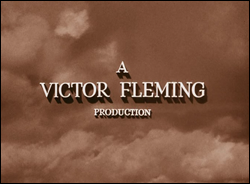
 
[This complete listing is taken from the fantastic book "The Wizardry of Oz" - Buy it at Amazon.com!!]
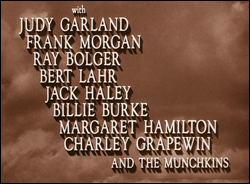
CAST:
Judy Garland as Dorothy Gale
Frank Morgan as Professor Marvel, Doorman, Cabby, Guard, The Wizard of Oz
Ray Bolger as Hunk Andrews/Scarecrow
Bert Lahr as Zeke/Cowardly Lion
Jack Haley as Hickory Twicker/Tin Woodman
Margaret Hamilton as Miss Almira Gulch/Wicked Witch of the West
Billie Burke as Glinda, the Good Witch of the North
Charley Grapewin as Uncle Henry
Clara Blandick as Aunt Em
Pat Walshe as Nikko
The Singer Midgets as The Munchkins
Toto as Toto [Terry the dog]
UNCREDITED:
THE MUNCHKINS:
Click here for pop-up window featuring a complete listing of all the people who portrayed The Munchkins
WINGED MONKEYS:
Buster BrodyHarry Cogg
Sid Dawson
Walter Miller
Harry Monty
Lee Murray
George Noison
Jack Paul
WINKIES:
Philip Harron
Mitchell Lewis (Leader)
Ambrose Schindler
Bob Steangelo
Harry Wilson
EMERALD CITY CITIZENS:
Lorraine Bridges
Tyler Brook
Charles Irwon
Lois January (Wash & Brush Up Salon Matron)
Ethereda Leopold (Wash & Brush Up Salon Beautician)
Dona Massin (Wash & Brush Up Salon Manicurist)
Elvida Rizzo
Helen Seamon (Woman with cat)
Oliver Smith
Ralph Sudam
Bobby Watson
DOUBLES:
For Judy Garland:
Bobbie Koshay & Caren Marsh (stand-in)
For Frank Morgan: Paul Adams
For Ray Bolger: Stafford Campbell
For Bert Lahr: Jim Jawcett, Pat Moran
For Jack Haley: Harry Masters
For Margaret Hamilton:
Betty Danko & Eileen Goodwin (broom-riding stunt)
For Pat Walshe: Freddie Retter
SPECIAL VOICES:
Nicke Angelo (Munchkin)
Billy Bletcher (Mayor/Lollipop Guild/Munchkin)
Robert Bradford (Munchkin)
Lorraine Bridges (Lullaby League)
Adriana Caselotti (Juliet)
Lois Clements (Munchkin)
Pinto Colvig (Munchkin/Lollipop Guild)
Ken darby (Winkie Leader)
The Debutantes (Optimistic Voices/Munchkins)
Abe Dinovitch (Apple Trees/Munchkin)
Buddy Ebsen (group Tin Woodman choruses)
Zari Elmassian (Munchkin)
J.D. Jewkes (Munchkin)
Lois Johansen (Munchkin)
Virgil Johnasen (Munchkin)
The King's Men Octet (Munchkns)
Betty Rome (Lullaby Leage)
The Rhythmettes (Optimistic Voices)
The St. Joseph's Choir (Munchkins)
Harry Stanton (Lollipop Build/Coroner/Munchkin)
Georgia Stark (deleted "King of Forest" tag)
George Stoll (Munchkin)
Carol Tevis (Lullaby League)
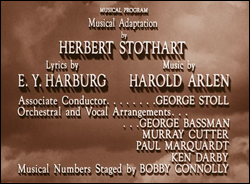
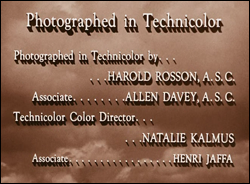
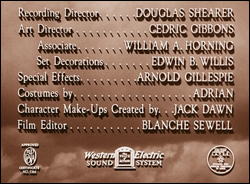
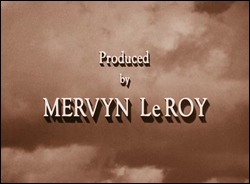
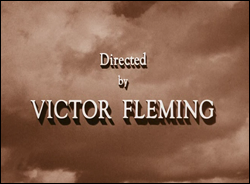
|
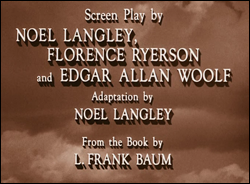
CREW:
PRODUCTION:
Producer: Mervyn LeRoy
Assistants to Mervyn LeRoy:
William Cannon & Barron Polan
Production Assistant: Arthur Freed
DIRECTION:
Director: Victor Fleming
Assistant to Victor Fleming: Al Schoenberg
Uncredited: George Cukor, Norman Taurog, Richard Thorpe, King Vidor
SCREENPLAY:
Noel Langley, Florence Ryerson, Edgar Allan Woolf
Uncredited:
Irving Brecher, William Cannon, Herbert Fields, Arthur Freed, E.Y. Harburg, Samuel Hoffenstein, John Lee Mahin, Herman Mankiewicz, Jack Mintz, Ogden Nash, Sid Silvers
Script Manager: Wallace Worsley
Assistant: Dave Marks
UNIT PRODUCTION:
Charlie Chic (Department Head)
Joe Cook (Assistant)
Ulrich Busch (Unit Production Manager)
Keith Weeks (Unit Production Manager)
CASTING:
W.L. Gordon (Assistant Casting Director)
Leonard Murphy
MUSICAL SCORE (MUSIC STAFF):
Lyrics: E.Y. "Yip" Harburg
Music: Harold Arlen
Musical Adaptation/Conductor: Herbert Stothart
Associate Conductor: George Stoll
[Musical score incorporates the works of Felix Mendelssohn and Modest Moussorgsky]
Music Department Head: Nat Finston
Orchestral & Vocal Arrangements: Leo Arnaud, George Bassman, Murray Cutter, Ken Darby, Paul Marquardt, Conrad Salinger, Bob Stringer
Piano Accompanist: Eddie Becker, Roger Edens (deleted "Over The Rainbow" reprise)
Violin Solos: Toscha Seidel
Dance Director: Bobby Connolly
Assistants: Arthur "Cowboy" Appell, Dona Massin, Busby Berkeley (deleted Scarecrow dance)
ART DEPARTMENT:
Department Head: Cedric Gibbons
Associate/Unit Art Directors: William A. Horning, Wade Rubottom
Lead Sketch Artist: Jack Martin Smith
Sketch Artists: Hugo Ballin, Malcolm Brown
Draftsmen: Preston Ames, Ed Carfagno, Conklin, Marvin Connell, Harvey Gillett, William Hellen, K. Johnson, Ted Rich, James Roth, Russ Spencer, Steffgen, Marvin Summerfield, John Thompson, Leo Vasian, "Woody" Woodward
Grauman's Chinese Theatre decorations: Elmer Sheeley
Backdrops: George Gibson (Scenic Art Director), Leo F. Atkison (clouds), John Coakley, Randall Duell, William Gibson, Clem Hall, F. Wayne Hill, Roy Perry, Clark M. Provins, Arthur Grover Rider, Duncan Spencer
PROPERTY SHOP:
Special Effects: Edwin Bloomfield, A. Arnold Gillespie (Department Head), Jack Gaylord (Assistant), Marcel Delgado (miniature monkeys), Mack Johnson, Jack McMaster, Hal Millar, Franklin Milton, Robert Overbeck, Glenn E. Robinson
SET DECORATION:
Edwin B. Willis (Department Head), Ray O'Brien (Assistant)
Company Props: Harry Edwards, Billy H. Scott, Charles B. Steiner
STAFF SHOP:
Henry Greutert (Chief Plaster Sculptor)
CAMERA:
John Arnold A.S.C. (Department Head), Harold Rosson A.S.C., Allen Davey A.S.C. (cameraman provided by Technicolor), Ray Ramsey, Sam Cohen, Max Fabian (special effects)
TECHNICOLOR:
Color Director: Natalie Kalmus, Associate: Henri Jaffa, Technicians: George Cave, Nelson Crodes, Fred Detmers, Henry Imus, Assistant: Clifford Shirpser
RECORDING DIRECTOR:
Douglas Shearer
SOUND:
Gavin Burns, Chip Gaither (sound boom [microphone])
ELECTRICIANS:
A.W. Brown, chirs Bergswich, Raymond Griffith, Shug Keeler
HEAD CAMERA GRIP:
Pop Arnold
FILM EDITORS:
Blanche Sewell, Ernie Grooney (Assistant), Margaret Booth
MATTE PAINTINGS:
Warren Newcombe, Candelario Rivas (Wicked Witch's Castle)
WARDROBE DEPARTMENT:
Costumes by Adrian
Sam Kress (Department Head) . Jack Rohan (Dresser: Men), Sheila O'Brien (Dresser: Women), Rose Meltzer, Vera Mordaunt, Marian Parker, Marie Rose, John B. Scura, Marie Wharton
MAKE-UP DEPARTMENT:
Charactor make-ups created by Jack Dawn (Department Head)
For Judy Garland: Webb Overlander
For Frank Morgan: Jack Dawn
For Ray Bolger: Norbert Miles
For Bert Lahr: Charles Schram
For Jack Haley: Lee Stanfield, Emile LaVigne
For Billie Burker: Lyle Wesley Dawn
For Margaret Hamilton: Jack Young
Josef Norin (Sculptor), Gustaf Norin (Sculptor/Lab Technician), Del Armstrong, Holly Bane, Don Cash, Jack Kevan, Louis LaCava, George Lane, Eddie Polo, Howart Smit, William Tuttle, Betty Masure (body make-up), Edith Wilson (body make-up)
WIGS:
Max Faxtor, Fred Frederick (Designer), Bob Roberts (Designer)
HAIRDRESSER:
Beth Langston
STILL PHOTOGRAPHERS:
Virgil Apger, George Hommel, Eric Carpenter (portrait gallery), Clarence Sinclair Bull (Billie Burke, Judy Garland with Toto)
ANIMAL TRAINERS:
Carl Spitz (Owner/Trainer of Toto/Terry), Jack Weatherwas (Toto Trainer), Freddy Gilman (Trainer of Munchkinland poines named Wizard and Os; Horse of a Different Color [impersonated by two horses named Mike and Ike, or Bill and Jake]), Curly Twifard (Trainer of Jim, the raven), Bill Richards (exotic birds)
PUBLICITY:
Howard Dietz, Andy Hervey, Mary Mayer (Unit Publicist), Si Seadler, Howard Strickling, Frank Whitbeck
M-G-M COMMISSARY:
Frances Edwards (Manager), special accomodations for the Oz unit
CATERER FOR THE SINGER MIDGETS:
Brittingham Commissary, Inc.
|
|
top of page
 |
 
Production Number: |
1060 |
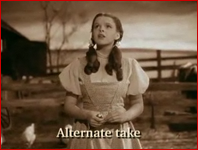 Click on image to view
the clever "Fun with OZ" video
that "Mark in NYC" has shared
Click on image to view
the clever "Fun with OZ" video
that "Mark in NYC" has shared
(redirects to The Judy Room's
Wizard of Oz Videos page) |
| Production Dates: |
October 13, 1938 to
March 16, 1939 |
| Production Cost: |
$2,777,000.00 |
| Running Time: |
103 minutes |
| Release Date: |
August 18, 1939 |
| Initial Box Office: |
$3,017,000.00
1948-49 re-release:
$1,564,000.00
1954-55 re-release: $465,000.00 |
ACADEMY AWARDS:
* = winner
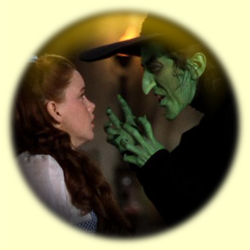 *
SPECIAL AWARD *
SPECIAL AWARD
To Judy Garland for her outstanding performance as a screen juvenile during the past year. [miniature statuette]
*
MUSIC (Original Score) -- Herbert Stothart
*
MUSIC (Song) -- "Over the Rainbow,"
Music by Harold Arlen; Lyrics by E. Y. Harburg
ART DIRECTION -- Cedric Gibbons, William A. Horning
CINEMATOGRAPHY (Color) -- Hal Rosson
[NOTE: THIS WAS NOT AN OFFICIAL NOMINATION. Title was on a preliminary list of submissions/nominees from the studios from which the two official nominees - Gone with the Wind and The Private Lives of Elizabeth and Essex - would be selected.]
OUTSTANDING PRODUCTION (BEST PICTURE) -- Metro-Goldwyn-Mayer
SPECIAL EFFECTS -- A. Arnold Gillespie, Douglas Shearer
top of page

BIBLIOGRAPHY:
The information on these pages comes from a variety of sources, including the websites linked below, but mainly from these wonderful books:
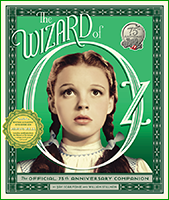
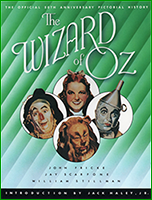 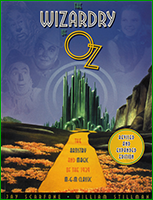 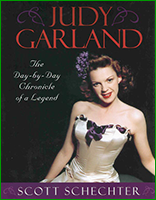 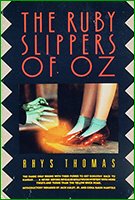
top of page

THANKS:
A huge THANK YOU to Sharon (of Curiosity Corner) Eric Hemphill and Daniel Petock for their invaluable support and contributions. I would also like to thank the folks out there who wish to remain anonymous on the Web - you know who you are!
Last, but not least, I must thank all of the fans over at The Judy Room's Facebook Page and Group. You all have contributed so much to the site that I can't thank you enough!
top of page

EXTERNAL LINKS:
There are tons of OZ related websites out there. The following is a list of the best and most informative. If you can't find what you're looking for here, one of these sites should have links to even more resources to help you in your quest.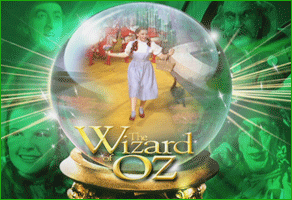
"Unofficial" 70th Anniversary Site
Curiosity Corner (OZ products blog)
International Wizard of Oz Club
The Wonderful Wizard of Oz Website
The Daily Ozmapolitan
The Royal Podcast of Oz
Wendy's Wizard of Oz Site
The Wonderful Blog of Oz
Wizard of Oz Wiki Project
Wikipedia Wizard of Oz Entry
Wiki Wizard of Oz Section
Wiki Wizard of Oz Project
The Wizard of Oz Online.net
Warner Bros. Official Site
BibliOdyssey - An Original Oz (the original book online)
U.S. Library of Congress Online Exhibition
top of page

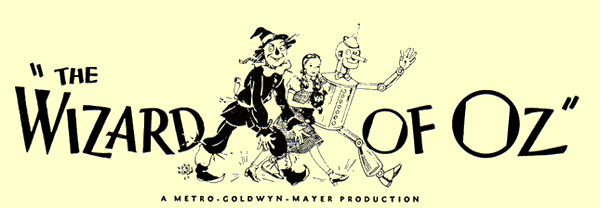

|
|
|

